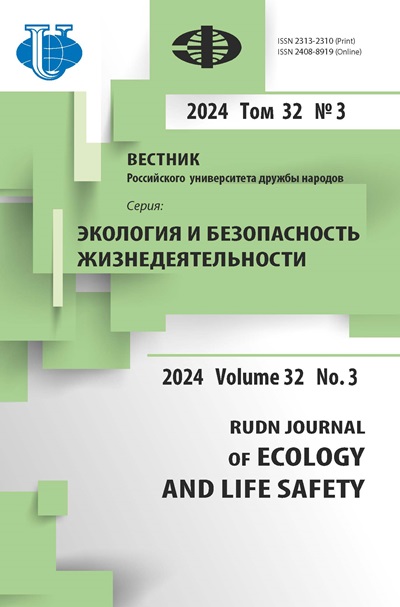Развитие системы экологического мониторинга кампуса РУДН
- Авторы: Хаустов А.П.1, Редина М.М.1, Силаева П.Ю.1, Кенжин Ж.Д.1
-
Учреждения:
- Российский университет дружбы народов
- Выпуск: Том 29, № 3 (2021)
- Страницы: 282-288
- Раздел: Экологический мониторинг
- URL: https://journals.rudn.ru/ecology/article/view/30559
- DOI: https://doi.org/10.22363/2313-2310-2021-29-3-282-288
Цитировать
Полный текст
Аннотация
Подводятся краткие итоги функционирования системы экологического мониторинга кампуса РУДН, созданной в 2017 г. Цель системы - получение данных о состоянии окружающей среды кампуса и прилегающей территории Юго-Западного лесопарка, которая рассматривается как условно фоновая. Территория окружена сетью автодорог с интенсивным движением автотранспорта, граничит с жилой застройкой и административной зоной. Техногенная нагрузка представлена в основном выбросами транспорта, как и на большей части Москвы. С этой точки зрения территория представляет собой репрезентативный объект для изучения, на котором запланировано продолжение работ по экологическому мониторингу и моделированию потоков загрязнителей, а также потоков парниковых газов. С начала наблюдений получено более 4000 записей об акустических и электромагнитных загрязнениях, а также о загрязненности атмосферного воздуха, почв, растительности, снегового покрова, что позволяет с уверенностью выделять зоны влияния транспортных потоков на территорию, моделировать миграцию загрязняющих веществ и разработать основы оценки экосистемных услуг территории. В частности, оценки эмиссий и поглощения парниковых газов почвенно-растительным комплексом.
Об авторах
Александр Петрович Хаустов
Российский университет дружбы народов
Автор, ответственный за переписку.
Email: khaustov-ap@rudn.ru
ORCID iD: 0000-0002-5338-3960
доктор геолого-минералогических наук, профессор, ведущий специалист Института экологии
Россия, 117198, Москва, ул. Миклухо-Маклая, д. 6Маргарита Михайловна Редина
Российский университет дружбы народов
Email: khaustov-ap@rudn.ru
ORCID iD: 0000-0002-3169-0142
доктор экономических наук, доцент, профессор департамента экологической безопасности и менеджмента качества продукции, Институт экологии
Россия, 117198, Москва, ул. Миклухо-Маклая, д. 6Полина Юрьевна Силаева
Российский университет дружбы народов
Email: silaeva-pyu@rudn.ru
ORCID iD: 0000-0002-7090-481X
магистр экологии, Институт экологии
Россия, 117198, Москва, ул. Миклухо-Маклая, д. 6Жандос Даудович Кенжин
Российский университет дружбы народов
Email: kenzhin-zh@rudn.ru
ORCID iD: 0000-0001-9655-8049
магистр экологии, ассистент департамента экологической безопасности и менеджмента качества продукции, Институт экологии
Россия, 117198, Москва, ул. Миклухо-Маклая, д. 6Список литературы
- Боева Д.В., Хаустов А.П. Оценка влияния автотранспорта на территорию кампуса Российского университета дружбы народов // Вестник Российского университета дружбы народов. Серия: Экология и безопасность жизнедеятельности. 2018. Т. 26. №4. С. 419-430. http://dx.doi.org/10.22363/2313-2310-2018-26-4-419-430
- Редина М.М., Хаустов А.П., Ли С., Кенжин Ж.Д., Силаева П.Ю. Показатели опасности загрязнения городских почв полициклическими углеводородами на примере результатов мониторинга кампуса РУДН // Вестник Российского университета дружбы народов. Серия: Экология и безопасность жизнедеятельности. 2020. Т. 28. № 2. С. 112-130. http://dx.doi.org/10.22363/2313-2310-2020-28-2-112-130
- Силаева П.Ю., Хаустов А.П. Транспортная нагрузка на кампус РУДН // Потаповские чтения - 2019: сборник материалов ежегодной Всероссийской научно-практической конференции, посвященной памяти доктора технических наук, профессора Александра Дмитриевича Потапова. М.: Изд-во МИСИ - МГСУ, 2019. С. 142-147. URL: http://mgsu.ru/resources/izdatelskaya-deyatelnost/izdaniya/izdaniya-otkr-dostupa/ (дата обращения: 10.01.2021).
- Хаустов А.П., Редина М.М. Фракционирование полициклических ароматических углеводородов на геохимических барьерах // Вестник Санкт-Петербургского университета. Науки о Земле. 2021. Т. 66. № 1. С. 123-143.
- Хаустов А.П., Редина М.М. Оценка пирогенного загрязнения почвенно-растительной системы на основе геохимических маркеров для локальной модели транспортной нагрузки // Антропогенная трансформация природной среды. 2021. Т. 7. № 1. С. 65-86. http://doi.org/10.17072/2410-8553-2021-1-65-86
- Хаустов А.П., Редина М.М., Алейникова А.М., Мамаджанов Р.Х., Силаева П.Ю. Проект экологического мониторинга кампуса Российского университета дружбы народов // Вестник Российского университета дружбы народов. Серия: Экология и безопасность жизнедеятельности. 2017. Т. 25. № 4. С. 562-584. http://dx.doi.org/10.22363/2313-2310-2017-25-4-562-584.
- Хаустов А.П., Кенжин Ж.Д., Редина М.М., Алейникова А.М. Распределение поли-циклических ароматических углеводородов в системе почва - растение под влиянием автотранспортных нагрузок городской среды // Почвоведение. 2021. № 7. С. 871-883. http://doi.org/10.31857/S0032180X21070066
- Khaustov A., Redina M. Justification of geochemical markers of the soil - plant system state for a local model of traffic pressure // Arabian Journal of Geosciences. 2021. Vol. 14. Article number 2845. https://doi.org/10.1007/s12517-021-08868-5
- Khaustov A., Redina M. Polycyclic aromatic hydrocarbons in the snow cover of Moscow (case study of the RUDN University campus) // Polycyclic Aromatic Compounds. 2021. Vol. 41. No 5. Pp. 1030-1041.
- Khaustov A., Redina M. Specificity of accumulation of hydrocarbons in various components of geosystems // E3S Web Conf. 2020. Vol. 169. Article number 01013. https://doi.org/10.1051/e3sconf/202016901013
- Khaustov A.P., Kenzhin Zh.D., Redina M.M., Aleinikova A.M. Distribution of polycyclic aromatic hydrocarbons in the soil - plant system as affected by motor vehicles in urban environment // Eurasian Soil Science. 2021. Vol. 54. No. 7. Pp. 1107-1118. http://doi.org/10.1134/S1064229321070061
- Khaustov A., Redina M., Kenzhin Zh., Gabov D., Yakovleva E. Identification of the state of the soil - plant systems on the RUDN University campus (based on PAH concentrations) // E3S Web Conf. 2020. Vol. 169. Article number 01015. https://doi.org/10.1051/e3sconf/202016901015
















